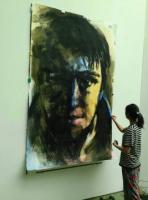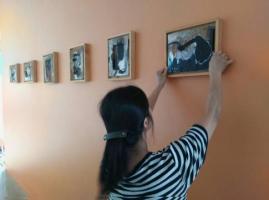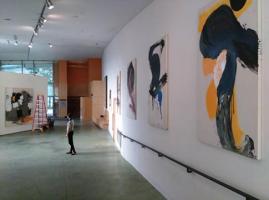The Michael S. Currier Center, Putney, VT September 10 – November 6, 2016, open daily to the public on the campus of The Putney School. This survey of Cai’s work includes her portraits and landscapes of the 1980s, ‘Edge’ series of the ’90s, ‘WuJi (Infinity Within)’ series of the past decade and recent monumental portraits. For further information: (802) 257-7898 or caixiart [at] gmail [dot] com. cxsilvergallery.com/cai-at-currier
You are cordially invited to the Artist Reception, Saturday September 24, 4:30 – 6:00 pm., at the Currier Center Galleryon the campus of The Putney School, 418 Houghton Park Road, Putney, VT. Inquiries: (802) 257-7898 or caixiart [at] gmail [dot] com.

Cai was in the first generation of art students after universities in China reopened after The Cultural Revolution. This four-decaderetrospective at Currier Art Center of Cai’s work traces a path from the Shanghai Style of the ’80s, with color used straight from the tube and brushwork with bold and loose strokes, to the present through a selection of Cai’s portraits, landscapes and abstractions.
The process of my portraits are dialoguing with each person, connecting with their inner beauty and their stories, a journey that shares and celebrates each person’s unique experience, time and space. The experience of ‘Edge’ is about stepping into and out of myself. Chinese traditional breathing exercise, qi gong, continues to help me channel energy when I paint. Materials, surface and texture are self-renewing areas of exploration. While living in New York in the 90s, I derived inspiration from cement sidewalks, the subway, and weathered walls. Everywhere I went, I kept discovering painting in my surroundings. Wu Ji (Infinity Within) is the concept of qi-yun ‘flow of energy into balance’ which is not just movement but also related to the vitality of the composition, the interaction of the painting medium, the forms depicted, and the painting surface. I appreciate the 17th century Mustard Seed Garden Manual of Painting – still useful today – which emphasizes “the close relationship between painting and calligraphy” and “the traditional view that painting is not a profession but an extension of the art of living.”
– Cai Xi
Sometimes, you have to pass through a gallery, looking, smelling – almost touching – works of art, taking them in, in a very physical way, and then you step away and let the effect wash over you, feeling the pieces, sequentially, as waves of an ocean surge and ebb, pulsing, receding, for a long time after you have left the scene. Later, wanting to reconnect, you come to the work again with a whole new body – new eyes, for sure. It enters your consciousness with a different, sensuously powerful energy; and before you know it, you are swept along in the hypnotic dance of qi gong, discovering, in yourself, the steps the painter took when the painting was made. A corner turned, portraits reveal vistas of an earlier world, with faces of family members, farmers, fisher folk, and the like. A sturdy four-year-old in one picture sings to a finch in a birdcage, her entire being focused in that long-ago, invisible sound. In the other, she studies the lights and shadows of candles in a bowl. And landscapes take us to both times and places in China, long ago. Cai’s recent venture into socially engaged art – performances, experiences, installations – seems like a radical departure from all this, but in fact, it is a natural outgrowth, in a life that has seen enormous changes, emerging out of China’s Cultural Revolution, marriage to an American and transplantation to an alien culture, a new language, parenthood, teaching, food catering, and participation in a free-wheeling, mind-expanding MFA program, all at the same time. The Pink Slip Project, Art-as-Food-as-Art, and Our Meal Table are evidences of a greater perspective, in which Art-is-Life-is-Art. Like her work, Cai is never finished, never still even for a moment. But whether her work takes her to the kitchen, the canvas, the tai chi, the classroom, or the street, this warrior woman finds still-points, reflections, and time-warps to share with us, wherever she goes. Cai’s life and work give credence to a line from an old song of the 60’s, “Time keeps on slippin’, slippin’, slippin’ … into the Future.” Dance on, Sister Cai!
– Nye Ffarrabas
Even in the 1980s, Cai responded to assignments and creative practice with determination and joy. Already schooled in studio practice, Cai responded with strong, deeply felt portraits that are already masterly and indications of fierce talent. In her later work, large tai-chi-like gestures are massage-like in their rawness. Cai has a way of literally throwing her body, mind and soul into her painting, a method which results in passionate/poetic communications. Cai’s college teacher in early 1980s China said, “Wherever you go; don’t give up an opportunity to learn and be inspired.” I am thinking about how that teaching method has resulted in Cai’s present practice of not only making her home an art-life center of creativity via food as art, communication as art, dealing with life issues with others as art but also Cai’s Putney School experience of taking her students to China. Sort of duplicating her teacher’s axiom of going to the source! As artist-teacher, Cai continues her teacher’s courage to go into the unknown to create and find inspiration. Cai, like all artists who follow the muse of their inner voice, has been and continues to be in touch with inner voices that dictate her path. Her sensitivity is always shared, never ego-bound but stirring inside and shining so that those close to Cai, are taught by her focused art-light. Listen to what Cai says, a story of healing: “Then I realized that I had put myself in danger and that gave me a feeling of shock. I took that shock and started a doing a painting.” This is a good life-art recipe, and way to transfer pain into gain, into healing, into knowledge, a way that she practices, even now. Cai is a masterful-artist/lifeist. Thank you, Cai for your strong brush strokes; for your ability to translate persons to paint; for your courage to travel to the site of your vision.
– Linda Montano

Installation views, Cai Xi with her work:








